Tall, early-ripening variety of edible honeysuckle “Sinichka”
Many gardeners who grow honeysuckle in their gardens prefer Titmouse. This variety has a lot of positive characteristics - high yield, frost resistance. In the article we will talk in detail about the advantages and disadvantages of this honeysuckle and the agrotechnical requirements that it imposes.
What kind of honeysuckle is this?
Honeysuckle Titmouse belongs to the edible varieties of early ripening. The first harvest is ready for harvest in the first half of June. The average yield is 55 c/ha.
The berries are tender, wrinkle easily, and can be stored even in the refrigerator for a maximum of 2-3 days.
Brief history of origin and distribution
The variety was bred by breeders of the Moscow nursery A. Skvortsov and A. Kuklina based on seedlings from the Magadan region and Kamchatka.
Honeysuckle Titmouse was included in the State Register of Russia in 1998.
Characteristics and description of bushes
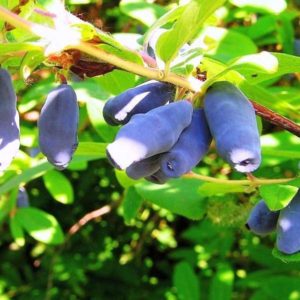
The variety is represented by vigorous (height 2 m or more), medium spreading bushes with a rounded crown and medium, curved and densely leafy shoots, which in the first year of life have slight pubescence and a light brown color.
The leaf blades are green, medium in size (length about 6.5 cm, width - 3 cm), pointed at the base, matte, heavily pubescent.
At the beginning of spring, during the flowering period, small bisexual pale yellow flowers appear on the bushes, collected in small inflorescences.
Reference. The bushes grow slowly during the first 2-3 years, reaching full size only by 6-7 years.
Temperature resistance
The titmouse is frost-resistant. The bushes can withstand air temperatures down to –30°C; the ovaries and buds do not freeze even at –5°C.
Moisture and drought resistance
Like other varieties of honeysuckle, Sinichka is a moisture-loving plant. But if the soil is waterlogged, there is a risk of rotting of the root system.
The bushes tolerate dry periods. Lack of moisture does not affect the development of bushes, but leads to a decrease in yield.
Resistance to diseases and pests
The variety has a fairly high immunity to diseases and pests characteristic of the crop. However, there is a risk of powdery mildew, phytoviruses, aphids, honeysuckle mites and fingerfly.
Characteristics and description of fruits
The berries are oblong-oval or ellipsoidal, the tip resembles a saucer, large - the average weight is 0.8-1 g. The skin is thin, at first yellowish-gray in color, after ripening it becomes almost black, covered with a bluish coating.
The pulp is tender, the taste is sweet and sour, refreshing.
Sinichka fruits contain 7.2% sugars, 2.2% organic acids, 74 mg of ascorbic acid (per 100 g).
Areas of their application
Most often, the berries of this honeysuckle are consumed fresh, which is explained by their short shelf life. In addition, the fruits are frozen, dried and dried, used for making compotes, cocktails, baking fillings, jams, juices and preserves. They even make homemade wine based on Sinichka.
Honeysuckle is also used in folk medicine to treat hypertension and cardiovascular diseases.
Advantages and disadvantages of the variety
The main advantages of honeysuckle Sinichka:
- ease of care;
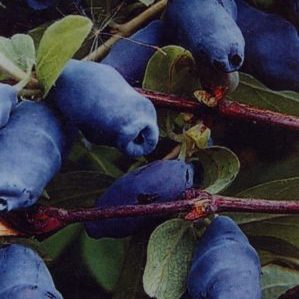
- resistance to diseases and pests;
- good yield;
- drought and frost resistance;
- pleasant, dessert taste and benefits of berries.
Disadvantages of the variety:
- low self-pollination;
- uneven ripening of fruits;
- tendency to shed quickly;
- poor keeping quality and transportability.
Growing technology
To growing honeysuckle this variety was successful, a number of nuances are taken into account regarding the timing, location and technology of planting, as well as the choice of planting material.
Strong seedlings 2-3 years old with a branched root system and buds on the branches are suitable for planting. Immediately before planting, the seedlings are inspected, all damaged and broken shoots and dry roots are removed and kept in a solution of growth stimulants (Kornevin, Epin) - this will improve the survival rate of the planting material.
Optimal conditions
For planting, Titmouse choose a sunny, illuminated place. In partial shade, the bushes also develop well, but the yield decreases.
The variety prefers fertile, moisture-permeable soil with aeration and neutral acidity. Loams would be an excellent option.
To minimize the likelihood of root system rotting due to high humidity, make sure that groundwater is at least 1 m from the soil surface.
Landing dates and rules
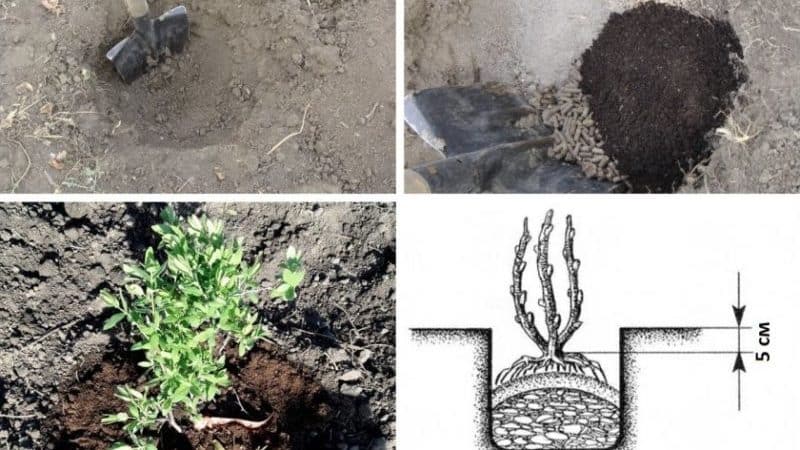
Honeysuckle is planted in early autumn (September) or spring, before the first buds open on the bushes.
Planting pattern:
- In the selected area, dig square planting holes measuring 40x40 cm.
- Pour compost or rotted humus into them and water generously.
- Make a small hill in the center, place a seedling on it, straighten its roots.
- Cover the seedling with soil so that the root collar is buried 2 cm or is at the level of the soil surface.
- Water the plants at the rate of 10 liters of water per bush.
- Mulch the tree trunk circle with peat or straw.
Bushes are planted at a distance of 1.5-2 m from each other.
Further care
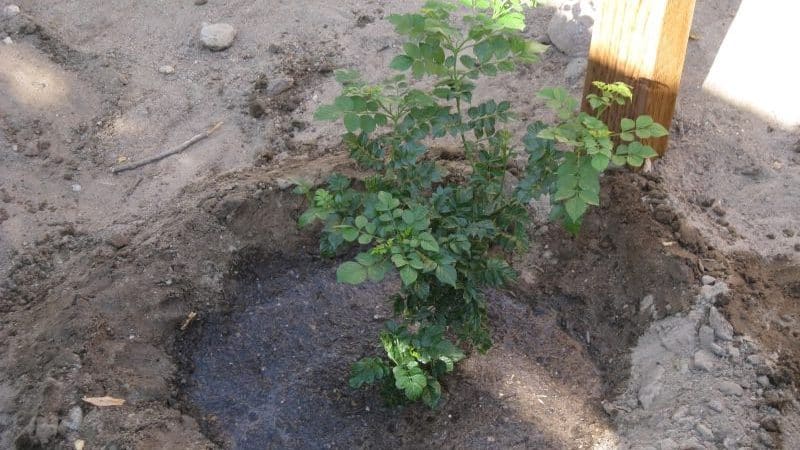
Titmouse is a moisture-loving variety. Regular watering is especially important during flowering and fruiting. During these periods, the bushes are watered 1-2 times a week, pouring 10 liters of water under each plant, and in dry weather - 15-20 liters.
The Titmouse is fed in the last months of autumn. A mixture of 5 kg of compost, 40 g of double superphosphate and 100-150 g of ash is used as fertilizer. In the spring, when the buds swell, the bushes are fed with ammonium nitrate at the rate of 15 g per 1 m².
Prune plants from 6 years of age. Every year, damaged, broken, dry and diseased shoots are removed from the bushes, cutting them off at the root. Every 3 years the crown is thinned out, leaving only strong and strong branches on it.
Important! When pruning the Titmouse, you cannot touch the top - there are buds with flowers on it.
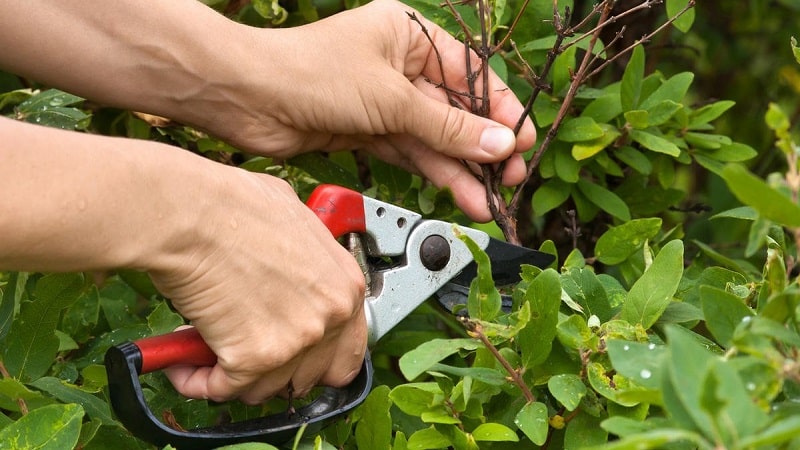
Possible problems, diseases, pests
Diseases and pests that can affect Titmouse are presented in the table.
| Disease/pest | Description | Treatment and prevention |
| Powdery mildew | A white powdery coating appears on the underside of the leaf blades. | Treat the bushes with Topaz.
For prevention in early spring, a 5% urea solution is poured onto the root zone of plants. |
| Phytoviruses | Light green spots appear on the leaves, and small brown dots appear along the central veins. | Infected plants cannot be cured; they are dug up and burned so that they do not infect other bushes.
To minimize the risk of infection by phytoviruses, seedlings are purchased from trusted places and the rules of plant care are followed. |
| Aphid | Small, green or black insects that feed on the sap of leaves. As a result, the leaves dry out and wither | Honeysuckle is treated with insecticidal preparations "Aktellik", "Aktara" or "Elexar".
For prevention, bushes are sprayed with infusion of tobacco, pepper or garlic. |
| Honeysuckle mite | Dark spots appear on the leaf blades; by the end of summer, the leaves turn brown and dry out. | The bushes are treated with insecticides or insectoacaricides - “Aktellik” or “Rogor”. Prevention of pests involves regular thinning of bushes. |
| Thumbwing | These pests feed on berry pulp and seeds. Unripe berries darken, wrinkle and crumble | To combat insects, use the drug “Inta-Vir” and water the bushes with infusion of potato or tomato tops.
For prevention, the agrotechnical requirements of the variety are observed and the bushes are watered with hot water in the spring to destroy the larvae. |
Wintering
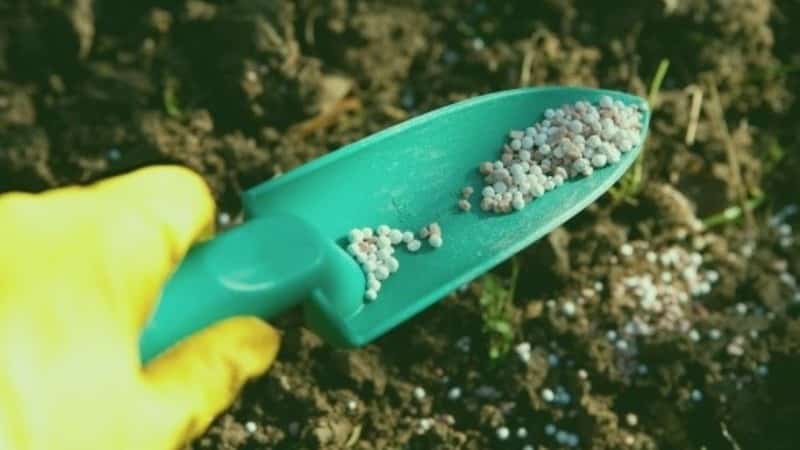
Despite the frost resistance of the variety and the lack of need for insulation and shelter, preparation for winter consists of several stages:
- In autumn, remove a layer of old mulch and fallen leaves from under the bushes.
- Dig up the soil in the tree trunk circle to a depth of 15-20 cm.
- Apply seasonal fertilizers.
- Tie young and thin shoots together to eliminate the possibility of them being damaged under the snow.
- Cover the bushes with burlap or a special net to prevent them from being damaged by birds or rodents.
Read also:
Reproduction
Honeysuckle Titmouse is propagated by cuttings, layering and seeds.
When cutting from young shoots, cut cuttings approximately 20 cm long and dig them in at an angle of 45°. If the soil is very dry, leave the cuttings in water overnight.
For propagation by layering, select a lower branch, tilt it to the ground, secure it with a wire bracket and dig it in. When an independent root system is formed on the shoot, it is separated from the main bush and planted in a permanent place.
In the case of seed propagation, dry planting material from selected fruits is used. In the fall, it is planted in a container with damp sand, covered with a lid and placed on the bottom shelf of the refrigerator.
In the spring, the seeds are planted in a box filled with a nutrient mixture, covered with polyethylene and put away in a semi-dark place on the site. When shoots appear, the film is removed, and in September the plants are transplanted into open ground.
Features of growing this variety depending on the region
The agrotechnical requirements of the Sinichka variety do not depend on the growing region. Thanks to its frost and drought resistance, this honeysuckle is successfully cultivated in all areas.
Pollinator varieties
The bushes are pollinated by bees, flies, and bumblebees. Due to the low self-pollination of the variety, pollinating varieties are planted nearby. As a result, the productivity of Titmouse increases and the taste of the berries improves. Two flowers produce one berry with two chambers inside.
The best pollinators for this honeysuckle are:
- Moskovskaya 23;
- Kamchadalka;
- Fortune;
- Cinderella;
- Start;
- Malvina.
Reviews from summer residents
Honeysuckle Sinichka was liked by gardeners, which is confirmed by their positive reviews:
Ivan, Bryansk: “I have been raising titmouse for a long time, more than 7 years for sure.This is actually the first honeysuckle that I planted on the site, so I didn’t suspect that it needed pollinators and there were no berries for a couple of years. A neighbor suggested what was going on, I bought several more honeysuckle bushes of other varieties, and then Sinichka began to bear fruit. I really like these berries - delicious, useful, ripen early."
Anna, Nizhnevartovsk: “For me, Sinichka is beyond competition. The bushes are beautiful, powerful, frost-resistant, and rarely get sick. The berries are sweet, with a pleasant light sourness. Plant care is minimal, the main thing is to water regularly.”
Victoria, Voronezh: “In our family, my husband is in charge of the garden; he looks after and cares for all the plants. He planted honeysuckle at my request; I really love these berries. We planted several varieties, not only for pollination, but also for comparison. In the end, we realized that Sinichka was the best. My husband likes that the bushes require virtually no care, and I liked the taste of the berries - sweet, but not cloying, with sourness.”
Conclusion
The honeysuckle variety Sinichka is characterized by high frost resistance, immunity to many diseases and pests, ease of care and a pleasant taste of healthy berries.
Among the disadvantages, only unsuitability for long-term storage and transportation, as well as a tendency to shed fruit, are noted.